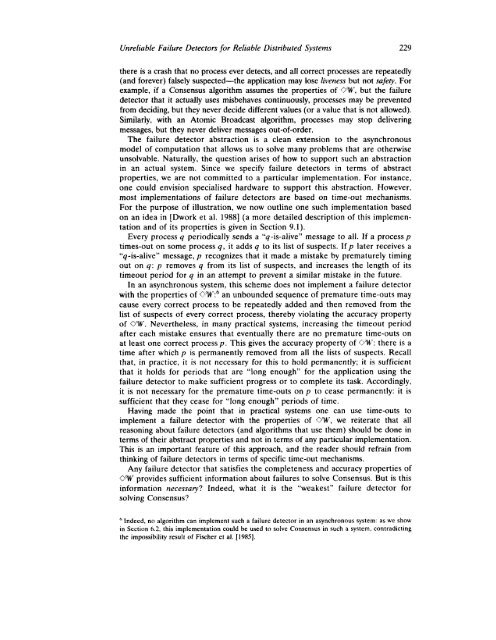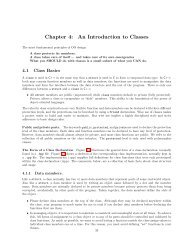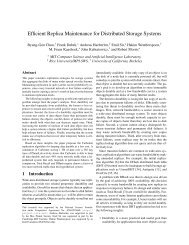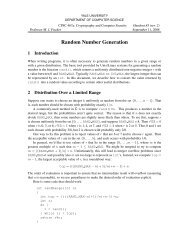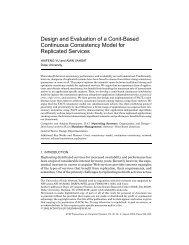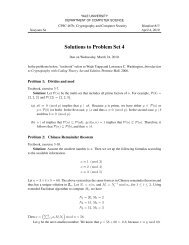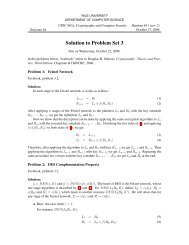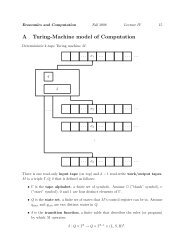Unreliable Failure Detectors for Reliable Distributed Systems
Unreliable Failure Detectors for Reliable Distributed Systems
Unreliable Failure Detectors for Reliable Distributed Systems
Create successful ePaper yourself
Turn your PDF publications into a flip-book with our unique Google optimized e-Paper software.
<strong>Unreliable</strong> Faiiure <strong>Detectors</strong> <strong>for</strong> <strong>Reliable</strong> <strong>Distributed</strong> <strong>Systems</strong> 229there is a crash that no process ever detects, and all correct processes are repeatedly(and <strong>for</strong>ever) falsely suspected—the application may lose liveness but not safe(y. Forexample, if a Consensus algorithm assumes the properties of OW, but the failuredetector that it actually uses misbehaves continuously, processes may be preventedfrom deciding, but they never decide different values (or a value that is not allowed).Similarly, with an Atomic Broadcast algorithm, processes may stop deliveringmessages, but they never deliver messages out-of-order.The failure detector abstraction is a clean extension to the asynchronousmodel of computation that allows us to solve many problems that are otherwiseunsolvable. Naturally, the question arises of how to support such an abstractionin an actual system. Since we specifi failure detectors in terms of abstractproperties, we are not committed to a particular implementation. For instance,one could envision specialised hardware to support this abstraction. However,most implementations of failure detectors are based on time-out mechanisms.For the purpose of illustration, we now outline one such implementation basedon an idea in [Dwork et al, 1988] (a more detailed description of this implementationand of its properties is given in Section 9.1).Every process q periodically sends a “q-is-alive” message to all. If a process ptimes-out on some process q, it adds q to its list of suspects. If p later receives a“q-is-alive” message, p recognizes that it made a mistake by prematurely timingout on q: p removes q from its list of suspects, and increases the length of itstimeout period <strong>for</strong> q in an attempt to prevent a similar mistake in the future.In an asynchronous system, this scheme does not implement a failure detectorwith the properties of OW:C an unbounded sequence of premature time-outs maycause every correct process to be repeatedly added and then removed from thelist of suspects of every correct process, thereby violating the accuracy propertyof OW. Nevertheless, in many practical systems, increasing the timeout periodafter each mistake ensures that eventually there are no premature time-outs onat least one correct process p. This gives the accuracy property of 07$”: there is atime after which p is permanently removed from all the lists of suspects. Recallthat, in practice, it is not necessary <strong>for</strong> this to hold permanently; it is sufficientthat it holds <strong>for</strong> periods that are “long enough” <strong>for</strong> the application using thefailure detector to make sufficient progress or to complete its task. Accordingly,it is not necessary <strong>for</strong> the premature time-outs on p to cease permanently: it issufficient that they cease <strong>for</strong> “long enough” periods of time.Having made the point that in practical systems one can use time-outs toimplement a failure detector with the properties of 074”, we reiterate that allreasoning about failure detectors (and algorithms that use them) should be done interms of their abstract properties and not in terms of any particular implementation.This is an important feature of this approach, and the reader should refrain fromthinking of failure detectors in terms of specific time-out mechanisms.Any failure detector that satisfies the completeness and accuracy properties ofOW provides sufficient in<strong>for</strong>mation about failures to solve Consensus. But is thisin<strong>for</strong>mation necessary? Indeed, what it is the “weakest” failure detector <strong>for</strong>solving Consensus?h Indeed, no algorithm can implement such a failure detector in an asynchronous system: as we showin Section 6.2, this implementation could be used to solve Consensus in such a system, contradictingthe impossibility result of Fischeret al. [1985].


